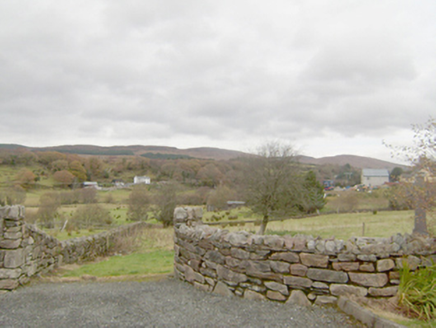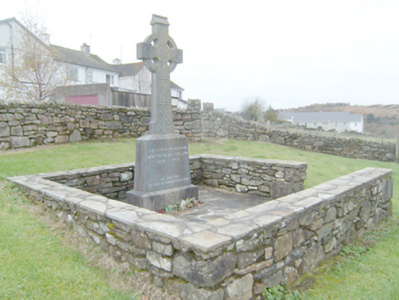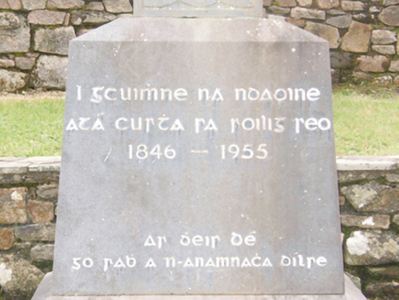Survey Data
Reg No
40837021
Rating
Regional
Categories of Special Interest
Artistic, Historical, Social
Original Use
Workhouse
In Use As
Monument
Date
1840 - 1955
Coordinates
181566, 394755
Date Recorded
16/11/2010
Date Updated
--/--/--
Description
Former union workhouse graveyard on sub rectangular-plan, in use c. 1845-1955, containing unmarked graves of victims of the Great Famine (1845-51), workhouse deaths from c. 1852- 1921 and later internments associated with St. Patrick's District Hospital from c. 1923-55. Now out of use with . Field stone boundary walls to site with rubble stone coping. Modern carved limestone Celtic high cross-type memorial to site (1997) having canted plinth with shaft and cross head over with Celtic interlacing motifs. Inscription in old Gaelic script to base. Cross set in modern rubble stone enclosure. Located in sloping site to the north of the site of Glenties Union Workhouse (demolished) and St. Columba’s Comprehensive School, and to the north-west of the centre of Glenties.
Appraisal
This sombre but relatively well-kept former graveyard was originally associated with the former Glenties Union Workhouse complex from c. 1845-1922, and was later in use as graveyard associated with St. Patrick’s District Hospital from c. 1922 until it was demolished in c. 1960 (closed 1958). It largely contains the unmarked graves of victims of the Great Famine (1845-51), and now acts as a poignant reminder of this traumatic event in Irish history. It is enclosed by simple but well-built rubble stone boundary walls. A carved limestone Celtic high cross-type memorial with intricate Celtic interlacing of artistic merit now provides some dignity to the site. Its preservation and maintenance demonstrates the local significance placed on the site, not least in providing a poignant area of reflection. Glenties Union Workhouse was originally built to standard designs by George Wilkinson between 1843-5 at a cost of £5,100 for the buildings and £940 for the fittings. It was designed to accommodate 500 inmates and first admissions took place on the 24th of July 1846. It was built on a site provided by the 2nd Marquis Conyngham, Francis Nathaniel Conyngham (1797-1876), the proprietor of the town of Glenties and the owner of vast estates in Donegal at the time of erection. Although designed to accommodate 500, the workhouse was grossly overcrowded during the famine with outbreaks of dysentery and other fevers common leading to one of the highest death rates for any workhouse in Ireland. It is likely that many thousands are buried in this graveyard. After Independence, the workhouse was modified for use as a hospital (St. Patrick’s District Hospital), and remained in use as such until 1958. Part of the facility was in use as a sanatorium in the 1950s under Dr. Noel Browne’s TB scheme. The hospital was later demolished and Glenties Comprehensive School built on the site in 1968.





